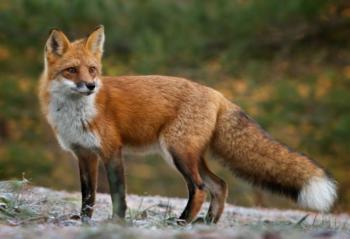 SKC Films Library SKC Films Library |
|
|
| SKC Films Library >> Science >> Zoology >> Mammals >> Order Carnivora >> Family Canidae |
| Red Fox Vulpes vulpes Description The red fox's fur is pale yellowish red to deep reddish brown on the upper parts and white, ashy or slaty on the underside. The lower part of the legs is usually black and the tail usually has a white or black tip. There are two common color variants. Cross foxes have reddish brown fur with a black stripe down the back and another across the shoulders. Silver foxes range from strong silver to nearly black and are the most prized by furriers. The eyes are yellow, and the nose is dark brown or black. With a length of up to 36 inches (not counting the tail, which can be 22 inches long) and weight of up to 24 pounds, this is the largest fox in the world. Populations in southern deserts and in North America are smaller than European populations. Body mass and length among populations also varies with latitude, with northern ones being larger. Red foxes have excellent senses of vision, smell, and touch. The tail, which is known as a brush, can be used by the fox as a warm cover in cold weather. Distribution and Habitat The red fox has the widest distribution of any wild carnivore, being found throughout most of the northern hemisphere from the Arctic circle to Central America, the steppes of central Asia, and northern Africa. It has also been introduced to Australia and the Falkland Islands. With such a wide distribution, it is little surprise that the red fox inhabits a wide range of habitats including forest, tundra, prairie, desert, mountains, farmlands, and urban areas, from sea level to about 14,760 feet. It prefers mixed vegetation communities, such as edge habitats and mixed scrub and woodland, however. Habits and Behaviors Unlike most canids, the red fox is primarily solitary. Ranges are occupied by an adult male and one or two adult females with their associated young. Individuals and family groups have main earthen dens and often other emergency burrows in the home range. Dens of other animals, such as rabbits or marmots, are often taken over by foxes. Larger dens may be dug and used during the winter and during birth and rearing of the young. The same den is often used over a number of generations. Pathways throughout the home range connect the main den with other resting sites, favored hunting grounds, and food storage areas. Animals remain in the same home range for life. Range size varies depending on quality of habitat, being larger in poorer habitats. Twenty-eight different kinds of vocalizations have been described in red foxes, and individuals have voices that can be distinguished. Vocalizations are used to communicate with foxes that are both nearby and very far away. They also use facial expressions and scent marking extensively. Diet Red foxes prey on voles, rabbits, hares, and other small mammals, as well as birds and invertebrates (especially beetles and earthworms). They will also eat carrion and items scavenged from dustbins, bird tables, and compost heaps. Red foxes have a characteristic manner of hunting mice. The fox stands motionless, listening and watching intently for a mouse it has detected. It then leaps high and brings the forelimbs straight down forcibly to pin the mouse to the ground. Red foxes also store food, and are very good at relocating their caches. Reproduction Mating behavior varies substantially. Males (dogs) and females (vixens) are usually monogamous, but males with multiple female mates are also known, as are male/female pairs that use non-breeding female helpers in raising their young. Females mated to the same male fox may share a den. Red fox groups always have only one breeding male, but that male may also seek mating outside of the group. Breeding season varies according to geography; December-January in the south, January-February in the central regions, and February-April in the north. Just before and for a time after giving birth the female remains in or around the den. The male partner will provision his mate with food but does not go into the maternity den. Gestation is typically between 51 and 53 days. Litters vary in size from 1 to 13 kits, with an average of 5. The kits are born blind, but open their eyes 9 to 14 days after birth. Kits leave the den 4 or 5 weeks after birth, and are fully weaned by 8 to 10 weeks. The mother begins feeding her kits regurgitated food, but eventually she will bring them live prey to "play" with and eat. The kits leave their mother when they are about seven months old. Scientific Classification phylum Chordata
WEB SOURCE |
| SKC Films Library >> Science >> Zoology >> Mammals >> Order Carnivora
>> Family
Canidae This page was last updated on May 06, 2017. |
